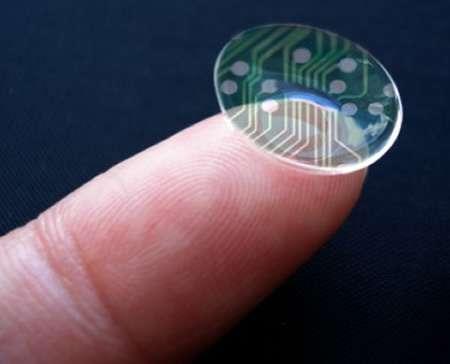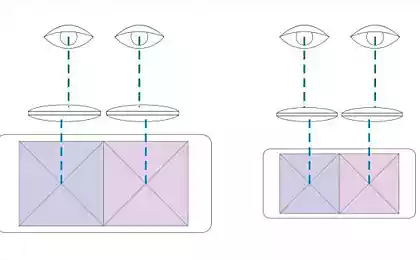504
Contact lenses with megapixel display
Now researchers of the company "INVEGA" develop contact lenses that enhance vision through a tiny full-color megapixel displays.
According to Willie, in recent months, failed to demonstrate the optics in the contact lenses for mobile devices including smartphones portable game devices and media players that deliver panoramic high resolution for entertainment and other apps of augmented reality.

The new system consists of improved contact lenses, working with light weight optical devices. The human eye has limited ability to focus on objects that are very close. Contact lenses contain electronics, which focuses the image located before the optical device on the light-sensitive retina in the fundus, allowing the user clearly to see them.
Conventional mobile device screens are often too small for comfortable reading, and, according to Willie, they are certainly very small for entertainment. Well contact lens company "INVEGA" can effectively mimic displays with a screen size equivalent to a 240-inch television, observed at a distance of 3 meters.
Moreover, by projecting slightly different images to the eye the display can generate the illusion of 3D. "You get full 3D, full HD, fully panoramic images," says Willie.

Although many do not recognize contact lenses, many millions of people already wear including 20 percent main target group of people aged 18 to 34 years who love computer games and smart phones. "So, we already have its market, says Willie. – We anticipate that people who buy lenses every six months or so, you can go to our lens by selecting them from the same suppliers that now."
Possible consumer applications include immersive video, 3D games, mobile device interfaces and augmented reality applications. Speaking about a possible application in the military sphere, this could be a perfect computer interface for the troops something that's fully transparent and hands-free.
"Think of those piloting the flying or neutralizing a bomb drones — adds Willie. – Or the doctors who will be able to quickly receive and send information to the soldier or to the headquarters. Or the soldiers in arms who need a display with incredibly detailed data, such as, for example, multi-colored and detailed map, but nothing should be in front of their eyes in order to safety and mobility".
Possible medical applications include helping those who have problems with eyesight, including macular degeneration – a disease of many, when the retina loses the ability to distinguish details. You can imagine and a tiny camera built into the nose points, allowing the media to make the text on the screen or on a tin, explains Willie.
Scientists from Washington University conducted a study on contact lenses that have displays within. But what they managed to achieve is one or two pixels with built-in lens LEDs and a short stint because of a lack of energy. But, according to Willie, his company can now offer megapixel displays. While the above research should be directed at development not displays and indicators to identify, for example, the level of sugar in the blood.

The company "INVEGA" plans to deliver prototypes in 2012-2013, with the necessary permissions will be obtained in 2012. In 2014, "Innovage" plans to start small-scale production for the purposes of the defense complex, and also for having eyesight problems. Commercial production will begin in 2014 or 2015 depending on whether it will be possible to conclude agreements with business partners such as gaming companies.
In addition to contact lens patents "Innovage" also include lens implanted in the eye. "In the year 900 thousand cataract surgery during which the lens is replaced by — says Willie. – Imagine if those people lens which helps to see not only real world but also virtual reality, but also provides access to the Internet."
Source: /users/104
According to Willie, in recent months, failed to demonstrate the optics in the contact lenses for mobile devices including smartphones portable game devices and media players that deliver panoramic high resolution for entertainment and other apps of augmented reality.

The new system consists of improved contact lenses, working with light weight optical devices. The human eye has limited ability to focus on objects that are very close. Contact lenses contain electronics, which focuses the image located before the optical device on the light-sensitive retina in the fundus, allowing the user clearly to see them.
Conventional mobile device screens are often too small for comfortable reading, and, according to Willie, they are certainly very small for entertainment. Well contact lens company "INVEGA" can effectively mimic displays with a screen size equivalent to a 240-inch television, observed at a distance of 3 meters.
Moreover, by projecting slightly different images to the eye the display can generate the illusion of 3D. "You get full 3D, full HD, fully panoramic images," says Willie.

Although many do not recognize contact lenses, many millions of people already wear including 20 percent main target group of people aged 18 to 34 years who love computer games and smart phones. "So, we already have its market, says Willie. – We anticipate that people who buy lenses every six months or so, you can go to our lens by selecting them from the same suppliers that now."
Possible consumer applications include immersive video, 3D games, mobile device interfaces and augmented reality applications. Speaking about a possible application in the military sphere, this could be a perfect computer interface for the troops something that's fully transparent and hands-free.
"Think of those piloting the flying or neutralizing a bomb drones — adds Willie. – Or the doctors who will be able to quickly receive and send information to the soldier or to the headquarters. Or the soldiers in arms who need a display with incredibly detailed data, such as, for example, multi-colored and detailed map, but nothing should be in front of their eyes in order to safety and mobility".
Possible medical applications include helping those who have problems with eyesight, including macular degeneration – a disease of many, when the retina loses the ability to distinguish details. You can imagine and a tiny camera built into the nose points, allowing the media to make the text on the screen or on a tin, explains Willie.
Scientists from Washington University conducted a study on contact lenses that have displays within. But what they managed to achieve is one or two pixels with built-in lens LEDs and a short stint because of a lack of energy. But, according to Willie, his company can now offer megapixel displays. While the above research should be directed at development not displays and indicators to identify, for example, the level of sugar in the blood.

The company "INVEGA" plans to deliver prototypes in 2012-2013, with the necessary permissions will be obtained in 2012. In 2014, "Innovage" plans to start small-scale production for the purposes of the defense complex, and also for having eyesight problems. Commercial production will begin in 2014 or 2015 depending on whether it will be possible to conclude agreements with business partners such as gaming companies.
In addition to contact lens patents "Innovage" also include lens implanted in the eye. "In the year 900 thousand cataract surgery during which the lens is replaced by — says Willie. – Imagine if those people lens which helps to see not only real world but also virtual reality, but also provides access to the Internet."
Source: /users/104























